Biomedical Engineering: AIS Anterior Approach Progress Report
VerifiedAdded on 2020/03/16
|24
|4395
|347
Report
AI Summary
This report presents a progress analysis on the anterior approach for treating Adolescent Idiopathic Scoliosis (AIS). It begins with an executive summary and table of contents, followed by an introduction that defines scoliosis and AIS, emphasizing the complexity of the three-dimensional deformity and the rationale for surgery. The report compares the anterior and posterior surgical methods, highlighting their advantages and disadvantages. It then details the anterior scoliosis surgery procedure, including patient positioning, incision techniques, and instrumentation. The report further explores management theories, including bureaucratic, human resource, patient-centered, and institutional theories, and how these approaches can be applied to reduce treatment costs, hospitalization duration, and improve patient outcomes. The methodology section outlines data collection and analysis, the work done so far, and future plans. The report concludes with a summary of findings and a list of references, including an appendix.
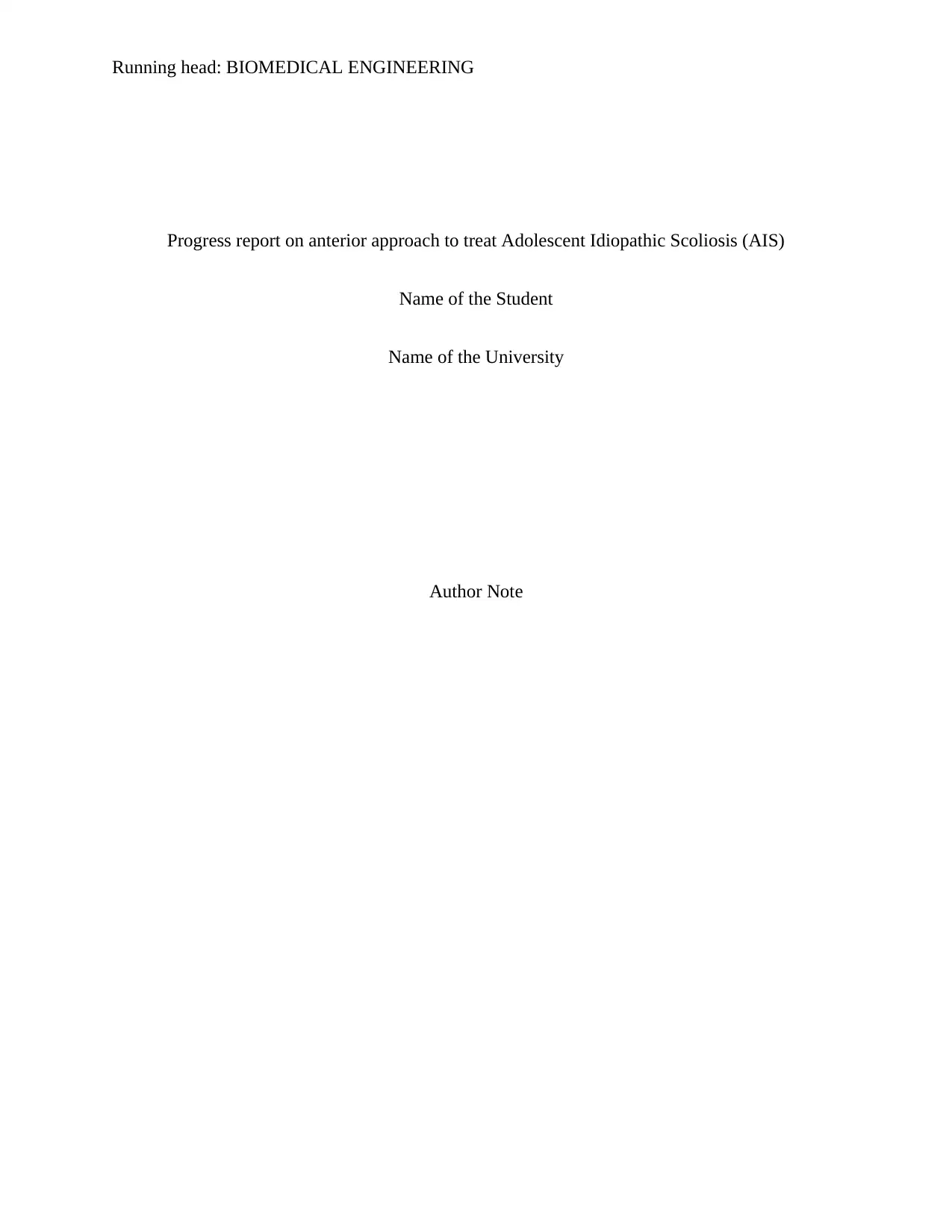
Running head: BIOMEDICAL ENGINEERING
Progress report on anterior approach to treat Adolescent Idiopathic Scoliosis (AIS)
Name of the Student
Name of the University
Author Note
Progress report on anterior approach to treat Adolescent Idiopathic Scoliosis (AIS)
Name of the Student
Name of the University
Author Note
Paraphrase This Document
Need a fresh take? Get an instant paraphrase of this document with our AI Paraphraser
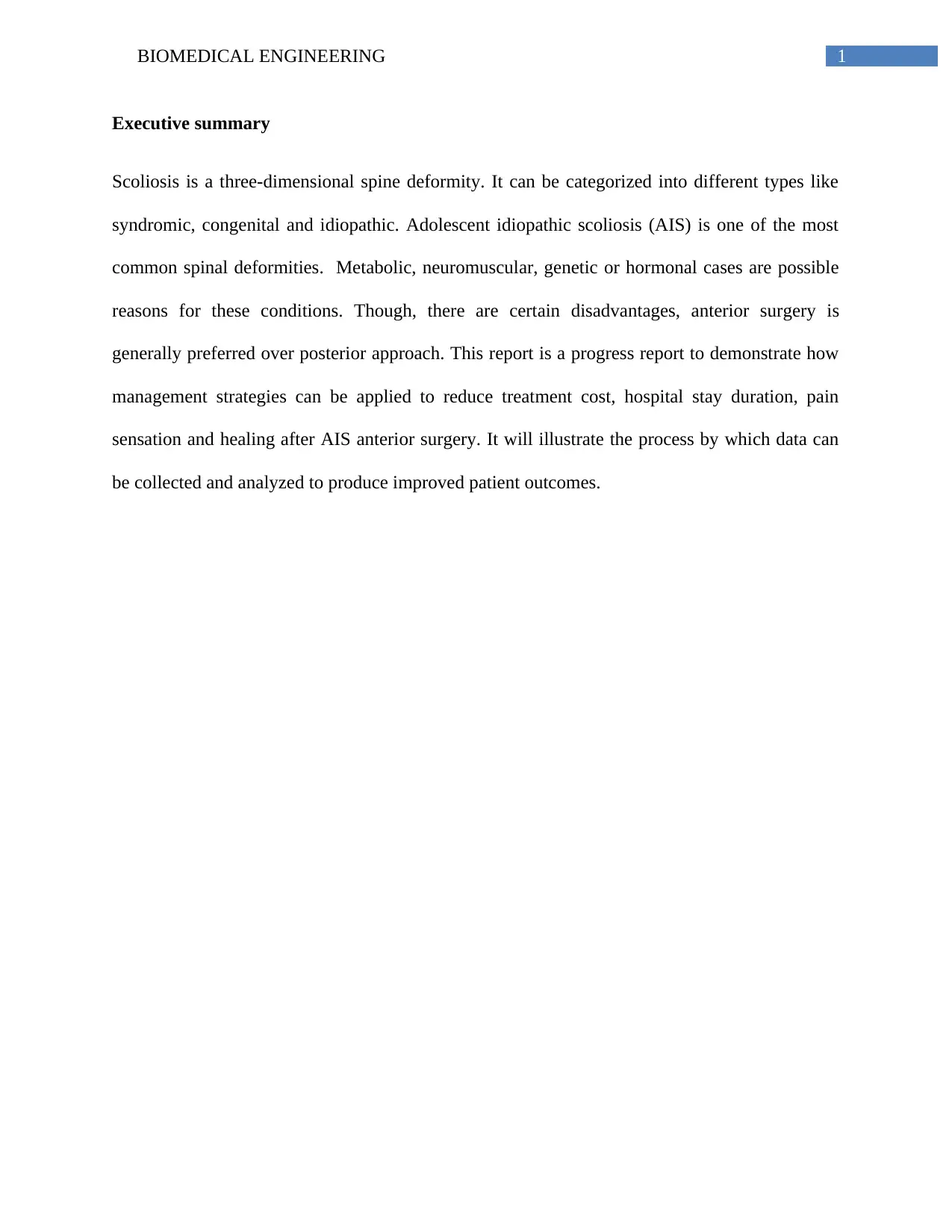
1BIOMEDICAL ENGINEERING
Executive summary
Scoliosis is a three-dimensional spine deformity. It can be categorized into different types like
syndromic, congenital and idiopathic. Adolescent idiopathic scoliosis (AIS) is one of the most
common spinal deformities. Metabolic, neuromuscular, genetic or hormonal cases are possible
reasons for these conditions. Though, there are certain disadvantages, anterior surgery is
generally preferred over posterior approach. This report is a progress report to demonstrate how
management strategies can be applied to reduce treatment cost, hospital stay duration, pain
sensation and healing after AIS anterior surgery. It will illustrate the process by which data can
be collected and analyzed to produce improved patient outcomes.
Executive summary
Scoliosis is a three-dimensional spine deformity. It can be categorized into different types like
syndromic, congenital and idiopathic. Adolescent idiopathic scoliosis (AIS) is one of the most
common spinal deformities. Metabolic, neuromuscular, genetic or hormonal cases are possible
reasons for these conditions. Though, there are certain disadvantages, anterior surgery is
generally preferred over posterior approach. This report is a progress report to demonstrate how
management strategies can be applied to reduce treatment cost, hospital stay duration, pain
sensation and healing after AIS anterior surgery. It will illustrate the process by which data can
be collected and analyzed to produce improved patient outcomes.
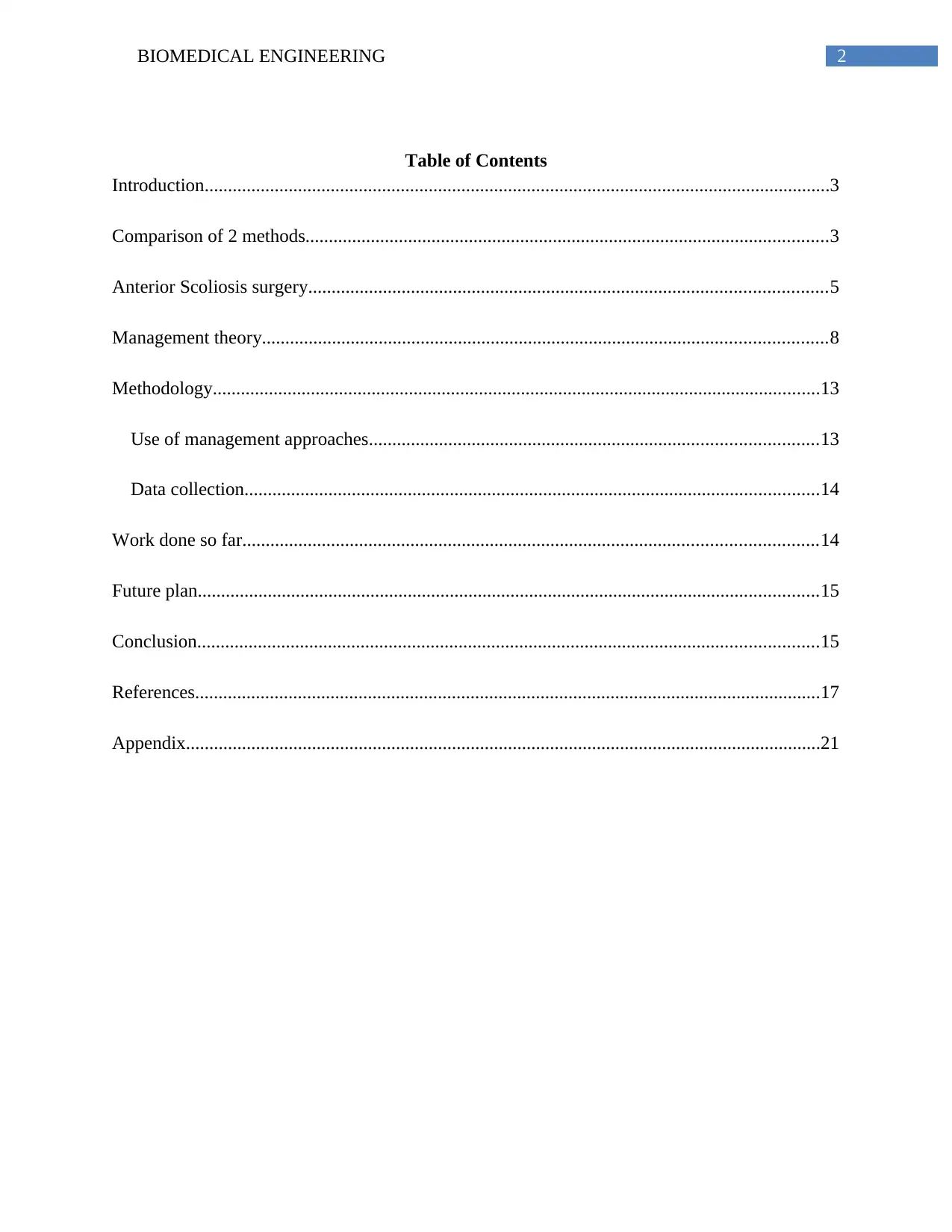
2BIOMEDICAL ENGINEERING
Table of Contents
Introduction......................................................................................................................................3
Comparison of 2 methods................................................................................................................3
Anterior Scoliosis surgery...............................................................................................................5
Management theory.........................................................................................................................8
Methodology..................................................................................................................................13
Use of management approaches................................................................................................13
Data collection...........................................................................................................................14
Work done so far...........................................................................................................................14
Future plan.....................................................................................................................................15
Conclusion.....................................................................................................................................15
References......................................................................................................................................17
Appendix........................................................................................................................................21
Table of Contents
Introduction......................................................................................................................................3
Comparison of 2 methods................................................................................................................3
Anterior Scoliosis surgery...............................................................................................................5
Management theory.........................................................................................................................8
Methodology..................................................................................................................................13
Use of management approaches................................................................................................13
Data collection...........................................................................................................................14
Work done so far...........................................................................................................................14
Future plan.....................................................................................................................................15
Conclusion.....................................................................................................................................15
References......................................................................................................................................17
Appendix........................................................................................................................................21
⊘ This is a preview!⊘
Do you want full access?
Subscribe today to unlock all pages.

Trusted by 1+ million students worldwide
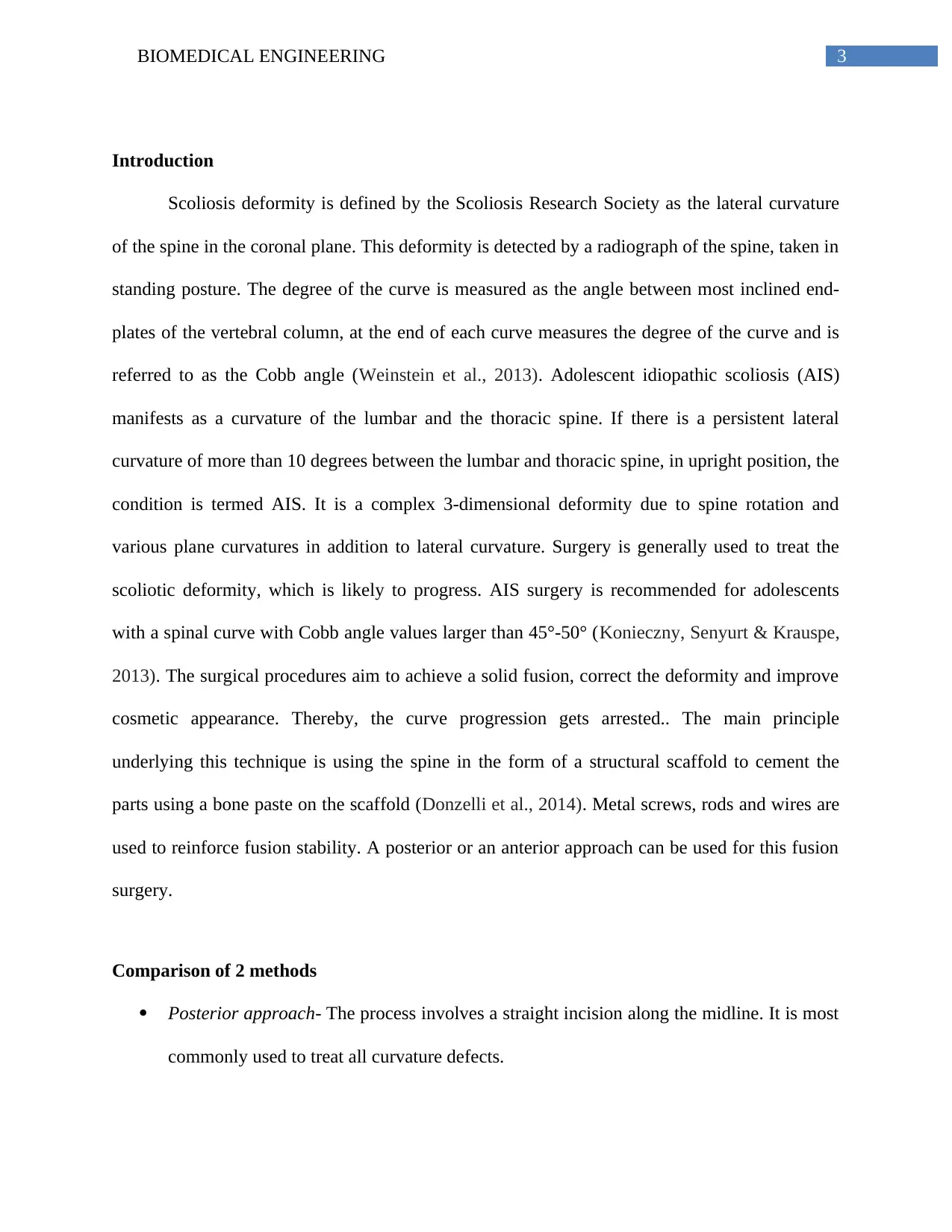
3BIOMEDICAL ENGINEERING
Introduction
Scoliosis deformity is defined by the Scoliosis Research Society as the lateral curvature
of the spine in the coronal plane. This deformity is detected by a radiograph of the spine, taken in
standing posture. The degree of the curve is measured as the angle between most inclined end-
plates of the vertebral column, at the end of each curve measures the degree of the curve and is
referred to as the Cobb angle (Weinstein et al., 2013). Adolescent idiopathic scoliosis (AIS)
manifests as a curvature of the lumbar and the thoracic spine. If there is a persistent lateral
curvature of more than 10 degrees between the lumbar and thoracic spine, in upright position, the
condition is termed AIS. It is a complex 3-dimensional deformity due to spine rotation and
various plane curvatures in addition to lateral curvature. Surgery is generally used to treat the
scoliotic deformity, which is likely to progress. AIS surgery is recommended for adolescents
with a spinal curve with Cobb angle values larger than 45°-50° (Konieczny, Senyurt & Krauspe,
2013). The surgical procedures aim to achieve a solid fusion, correct the deformity and improve
cosmetic appearance. Thereby, the curve progression gets arrested.. The main principle
underlying this technique is using the spine in the form of a structural scaffold to cement the
parts using a bone paste on the scaffold (Donzelli et al., 2014). Metal screws, rods and wires are
used to reinforce fusion stability. A posterior or an anterior approach can be used for this fusion
surgery.
Comparison of 2 methods
Posterior approach- The process involves a straight incision along the midline. It is most
commonly used to treat all curvature defects.
Introduction
Scoliosis deformity is defined by the Scoliosis Research Society as the lateral curvature
of the spine in the coronal plane. This deformity is detected by a radiograph of the spine, taken in
standing posture. The degree of the curve is measured as the angle between most inclined end-
plates of the vertebral column, at the end of each curve measures the degree of the curve and is
referred to as the Cobb angle (Weinstein et al., 2013). Adolescent idiopathic scoliosis (AIS)
manifests as a curvature of the lumbar and the thoracic spine. If there is a persistent lateral
curvature of more than 10 degrees between the lumbar and thoracic spine, in upright position, the
condition is termed AIS. It is a complex 3-dimensional deformity due to spine rotation and
various plane curvatures in addition to lateral curvature. Surgery is generally used to treat the
scoliotic deformity, which is likely to progress. AIS surgery is recommended for adolescents
with a spinal curve with Cobb angle values larger than 45°-50° (Konieczny, Senyurt & Krauspe,
2013). The surgical procedures aim to achieve a solid fusion, correct the deformity and improve
cosmetic appearance. Thereby, the curve progression gets arrested.. The main principle
underlying this technique is using the spine in the form of a structural scaffold to cement the
parts using a bone paste on the scaffold (Donzelli et al., 2014). Metal screws, rods and wires are
used to reinforce fusion stability. A posterior or an anterior approach can be used for this fusion
surgery.
Comparison of 2 methods
Posterior approach- The process involves a straight incision along the midline. It is most
commonly used to treat all curvature defects.
Paraphrase This Document
Need a fresh take? Get an instant paraphrase of this document with our AI Paraphraser
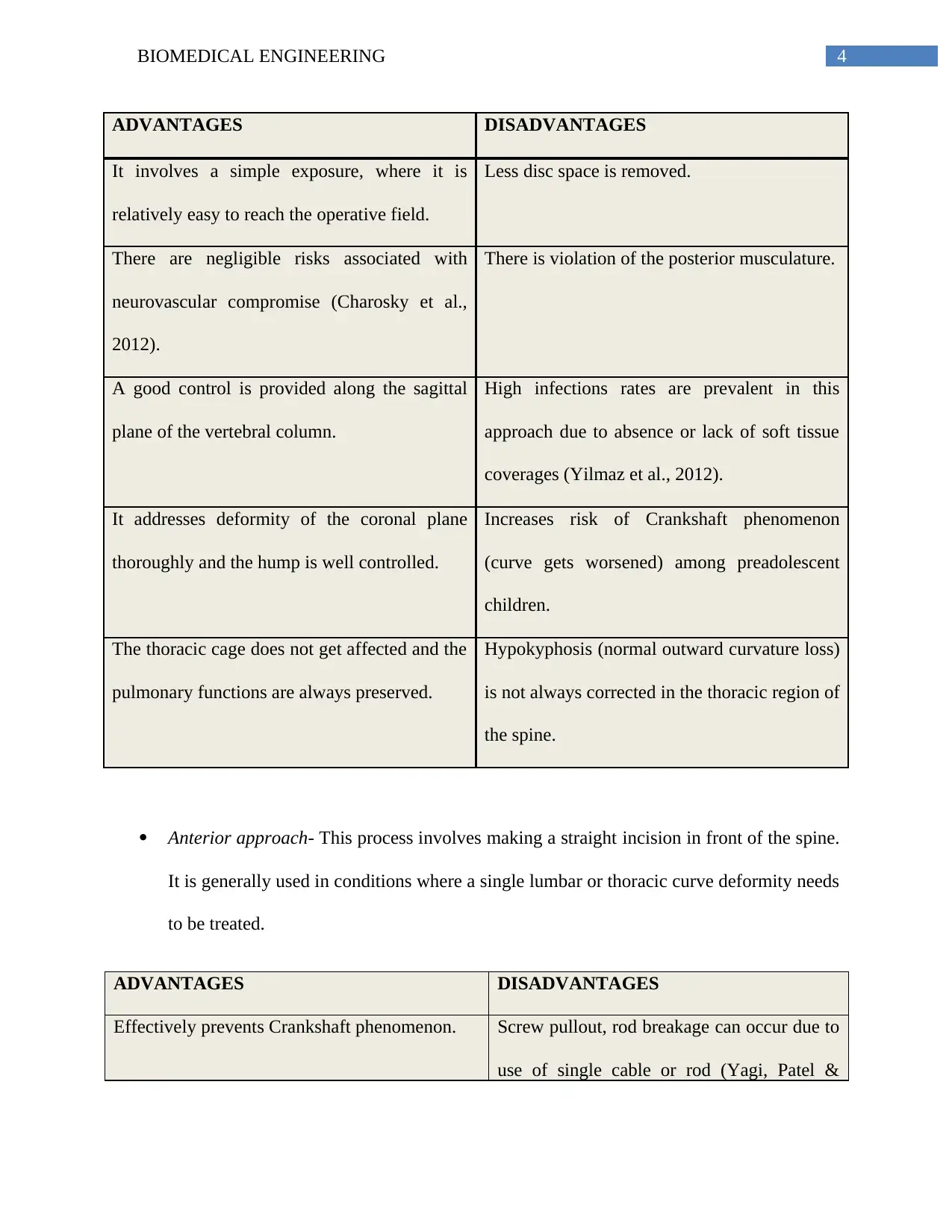
4BIOMEDICAL ENGINEERING
ADVANTAGES DISADVANTAGES
It involves a simple exposure, where it is
relatively easy to reach the operative field.
Less disc space is removed.
There are negligible risks associated with
neurovascular compromise (Charosky et al.,
2012).
There is violation of the posterior musculature.
A good control is provided along the sagittal
plane of the vertebral column.
High infections rates are prevalent in this
approach due to absence or lack of soft tissue
coverages (Yilmaz et al., 2012).
It addresses deformity of the coronal plane
thoroughly and the hump is well controlled.
Increases risk of Crankshaft phenomenon
(curve gets worsened) among preadolescent
children.
The thoracic cage does not get affected and the
pulmonary functions are always preserved.
Hypokyphosis (normal outward curvature loss)
is not always corrected in the thoracic region of
the spine.
Anterior approach- This process involves making a straight incision in front of the spine.
It is generally used in conditions where a single lumbar or thoracic curve deformity needs
to be treated.
ADVANTAGES DISADVANTAGES
Effectively prevents Crankshaft phenomenon. Screw pullout, rod breakage can occur due to
use of single cable or rod (Yagi, Patel &
ADVANTAGES DISADVANTAGES
It involves a simple exposure, where it is
relatively easy to reach the operative field.
Less disc space is removed.
There are negligible risks associated with
neurovascular compromise (Charosky et al.,
2012).
There is violation of the posterior musculature.
A good control is provided along the sagittal
plane of the vertebral column.
High infections rates are prevalent in this
approach due to absence or lack of soft tissue
coverages (Yilmaz et al., 2012).
It addresses deformity of the coronal plane
thoroughly and the hump is well controlled.
Increases risk of Crankshaft phenomenon
(curve gets worsened) among preadolescent
children.
The thoracic cage does not get affected and the
pulmonary functions are always preserved.
Hypokyphosis (normal outward curvature loss)
is not always corrected in the thoracic region of
the spine.
Anterior approach- This process involves making a straight incision in front of the spine.
It is generally used in conditions where a single lumbar or thoracic curve deformity needs
to be treated.
ADVANTAGES DISADVANTAGES
Effectively prevents Crankshaft phenomenon. Screw pullout, rod breakage can occur due to
use of single cable or rod (Yagi, Patel &
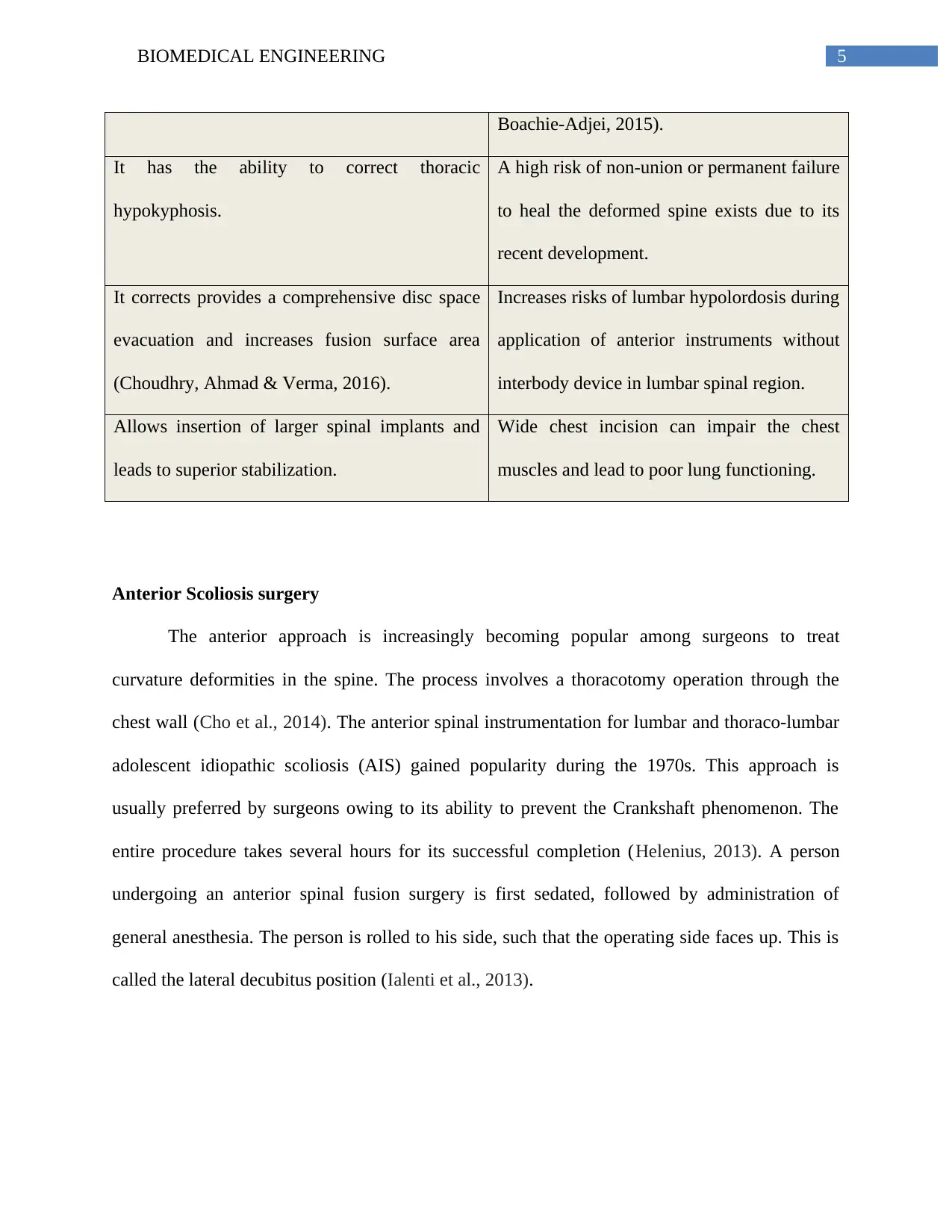
5BIOMEDICAL ENGINEERING
Boachie-Adjei, 2015).
It has the ability to correct thoracic
hypokyphosis.
A high risk of non-union or permanent failure
to heal the deformed spine exists due to its
recent development.
It corrects provides a comprehensive disc space
evacuation and increases fusion surface area
(Choudhry, Ahmad & Verma, 2016).
Increases risks of lumbar hypolordosis during
application of anterior instruments without
interbody device in lumbar spinal region.
Allows insertion of larger spinal implants and
leads to superior stabilization.
Wide chest incision can impair the chest
muscles and lead to poor lung functioning.
Anterior Scoliosis surgery
The anterior approach is increasingly becoming popular among surgeons to treat
curvature deformities in the spine. The process involves a thoracotomy operation through the
chest wall (Cho et al., 2014). The anterior spinal instrumentation for lumbar and thoraco-lumbar
adolescent idiopathic scoliosis (AIS) gained popularity during the 1970s. This approach is
usually preferred by surgeons owing to its ability to prevent the Crankshaft phenomenon. The
entire procedure takes several hours for its successful completion (Helenius, 2013). A person
undergoing an anterior spinal fusion surgery is first sedated, followed by administration of
general anesthesia. The person is rolled to his side, such that the operating side faces up. This is
called the lateral decubitus position (Ialenti et al., 2013).
Boachie-Adjei, 2015).
It has the ability to correct thoracic
hypokyphosis.
A high risk of non-union or permanent failure
to heal the deformed spine exists due to its
recent development.
It corrects provides a comprehensive disc space
evacuation and increases fusion surface area
(Choudhry, Ahmad & Verma, 2016).
Increases risks of lumbar hypolordosis during
application of anterior instruments without
interbody device in lumbar spinal region.
Allows insertion of larger spinal implants and
leads to superior stabilization.
Wide chest incision can impair the chest
muscles and lead to poor lung functioning.
Anterior Scoliosis surgery
The anterior approach is increasingly becoming popular among surgeons to treat
curvature deformities in the spine. The process involves a thoracotomy operation through the
chest wall (Cho et al., 2014). The anterior spinal instrumentation for lumbar and thoraco-lumbar
adolescent idiopathic scoliosis (AIS) gained popularity during the 1970s. This approach is
usually preferred by surgeons owing to its ability to prevent the Crankshaft phenomenon. The
entire procedure takes several hours for its successful completion (Helenius, 2013). A person
undergoing an anterior spinal fusion surgery is first sedated, followed by administration of
general anesthesia. The person is rolled to his side, such that the operating side faces up. This is
called the lateral decubitus position (Ialenti et al., 2013).
⊘ This is a preview!⊘
Do you want full access?
Subscribe today to unlock all pages.

Trusted by 1+ million students worldwide
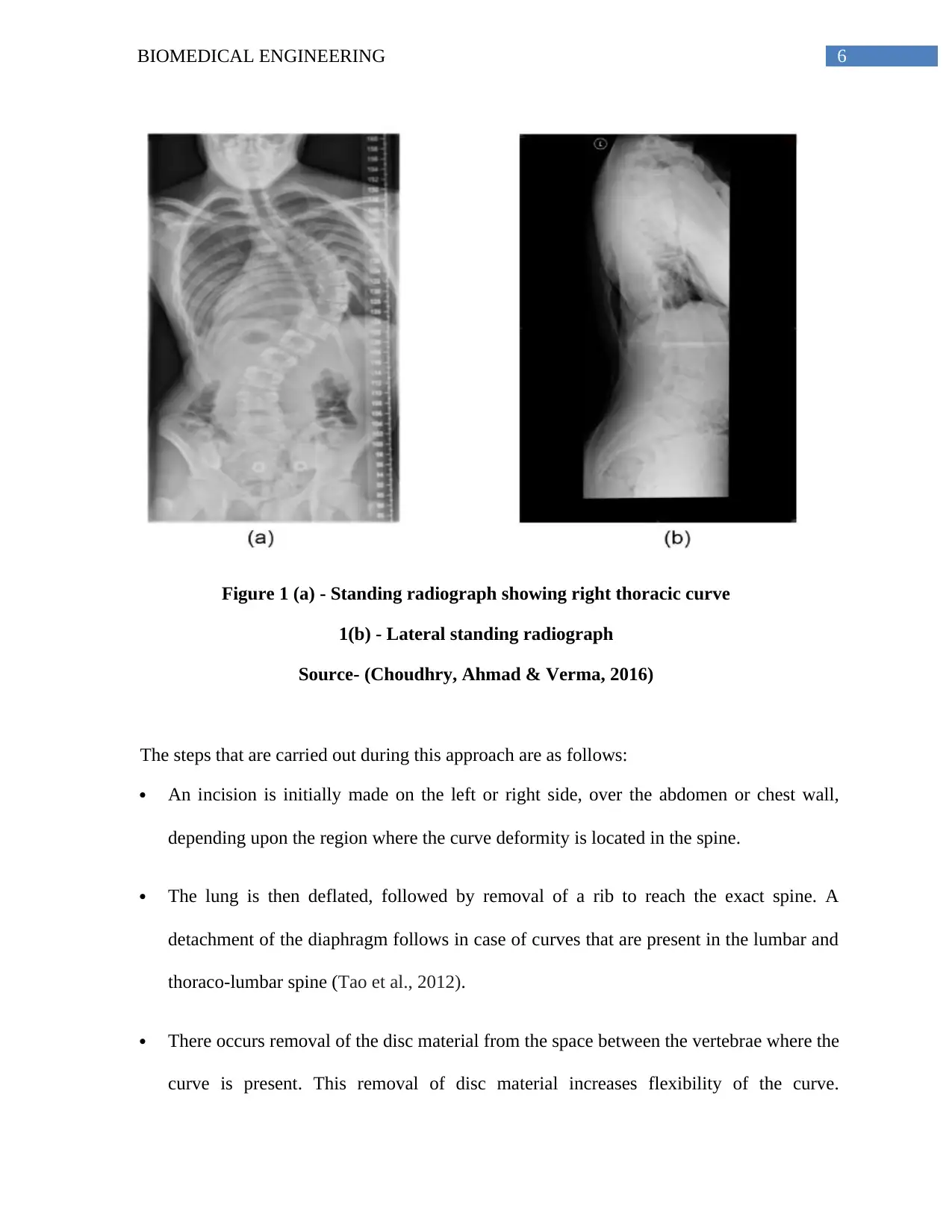
6BIOMEDICAL ENGINEERING
Figure 1 (a) - Standing radiograph showing right thoracic curve
1(b) - Lateral standing radiograph
Source- (Choudhry, Ahmad & Verma, 2016)
The steps that are carried out during this approach are as follows:
An incision is initially made on the left or right side, over the abdomen or chest wall,
depending upon the region where the curve deformity is located in the spine.
The lung is then deflated, followed by removal of a rib to reach the exact spine. A
detachment of the diaphragm follows in case of curves that are present in the lumbar and
thoraco-lumbar spine (Tao et al., 2012).
There occurs removal of the disc material from the space between the vertebrae where the
curve is present. This removal of disc material increases flexibility of the curve.
Figure 1 (a) - Standing radiograph showing right thoracic curve
1(b) - Lateral standing radiograph
Source- (Choudhry, Ahmad & Verma, 2016)
The steps that are carried out during this approach are as follows:
An incision is initially made on the left or right side, over the abdomen or chest wall,
depending upon the region where the curve deformity is located in the spine.
The lung is then deflated, followed by removal of a rib to reach the exact spine. A
detachment of the diaphragm follows in case of curves that are present in the lumbar and
thoraco-lumbar spine (Tao et al., 2012).
There occurs removal of the disc material from the space between the vertebrae where the
curve is present. This removal of disc material increases flexibility of the curve.
Paraphrase This Document
Need a fresh take? Get an instant paraphrase of this document with our AI Paraphraser
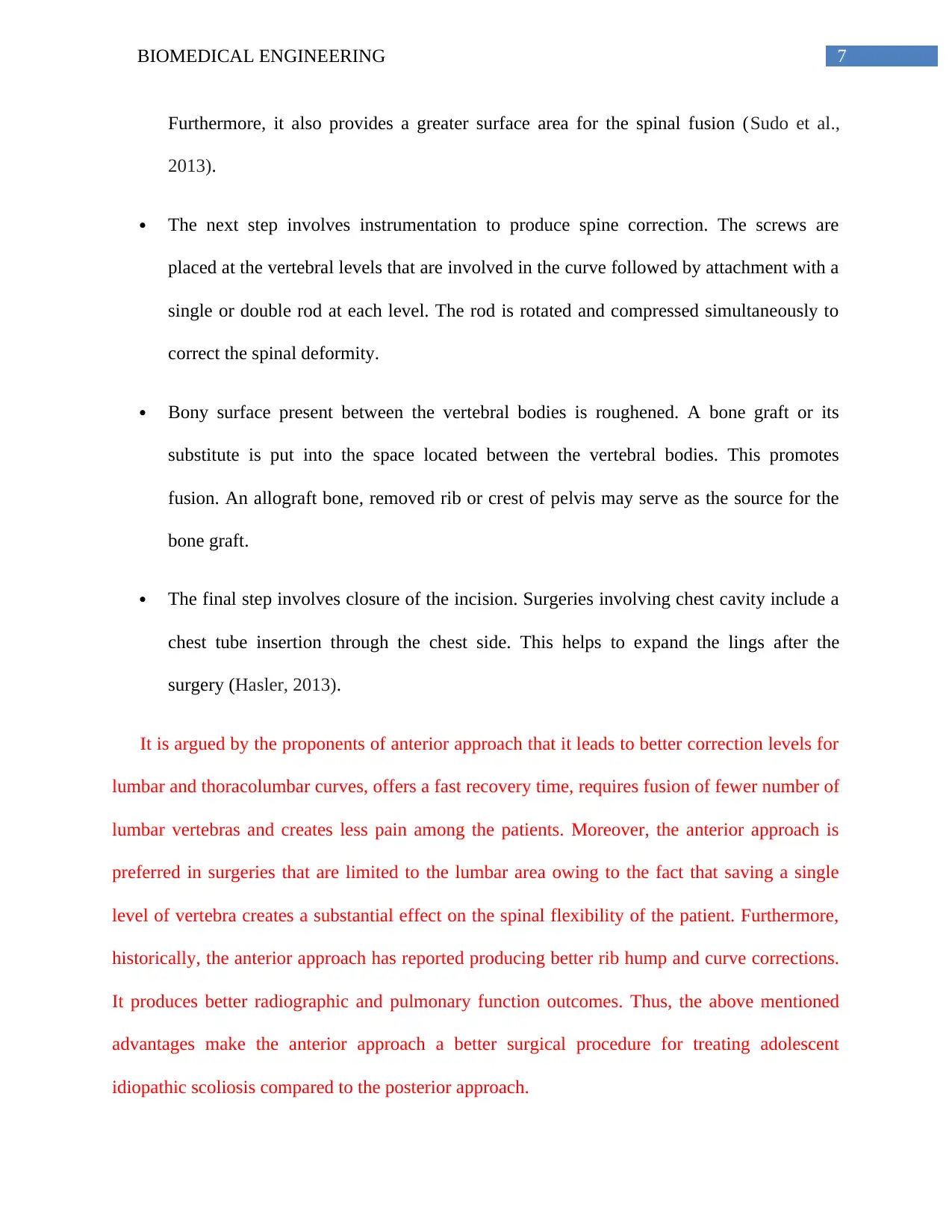
7BIOMEDICAL ENGINEERING
Furthermore, it also provides a greater surface area for the spinal fusion (Sudo et al.,
2013).
The next step involves instrumentation to produce spine correction. The screws are
placed at the vertebral levels that are involved in the curve followed by attachment with a
single or double rod at each level. The rod is rotated and compressed simultaneously to
correct the spinal deformity.
Bony surface present between the vertebral bodies is roughened. A bone graft or its
substitute is put into the space located between the vertebral bodies. This promotes
fusion. An allograft bone, removed rib or crest of pelvis may serve as the source for the
bone graft.
The final step involves closure of the incision. Surgeries involving chest cavity include a
chest tube insertion through the chest side. This helps to expand the lings after the
surgery (Hasler, 2013).
It is argued by the proponents of anterior approach that it leads to better correction levels for
lumbar and thoracolumbar curves, offers a fast recovery time, requires fusion of fewer number of
lumbar vertebras and creates less pain among the patients. Moreover, the anterior approach is
preferred in surgeries that are limited to the lumbar area owing to the fact that saving a single
level of vertebra creates a substantial effect on the spinal flexibility of the patient. Furthermore,
historically, the anterior approach has reported producing better rib hump and curve corrections.
It produces better radiographic and pulmonary function outcomes. Thus, the above mentioned
advantages make the anterior approach a better surgical procedure for treating adolescent
idiopathic scoliosis compared to the posterior approach.
Furthermore, it also provides a greater surface area for the spinal fusion (Sudo et al.,
2013).
The next step involves instrumentation to produce spine correction. The screws are
placed at the vertebral levels that are involved in the curve followed by attachment with a
single or double rod at each level. The rod is rotated and compressed simultaneously to
correct the spinal deformity.
Bony surface present between the vertebral bodies is roughened. A bone graft or its
substitute is put into the space located between the vertebral bodies. This promotes
fusion. An allograft bone, removed rib or crest of pelvis may serve as the source for the
bone graft.
The final step involves closure of the incision. Surgeries involving chest cavity include a
chest tube insertion through the chest side. This helps to expand the lings after the
surgery (Hasler, 2013).
It is argued by the proponents of anterior approach that it leads to better correction levels for
lumbar and thoracolumbar curves, offers a fast recovery time, requires fusion of fewer number of
lumbar vertebras and creates less pain among the patients. Moreover, the anterior approach is
preferred in surgeries that are limited to the lumbar area owing to the fact that saving a single
level of vertebra creates a substantial effect on the spinal flexibility of the patient. Furthermore,
historically, the anterior approach has reported producing better rib hump and curve corrections.
It produces better radiographic and pulmonary function outcomes. Thus, the above mentioned
advantages make the anterior approach a better surgical procedure for treating adolescent
idiopathic scoliosis compared to the posterior approach.
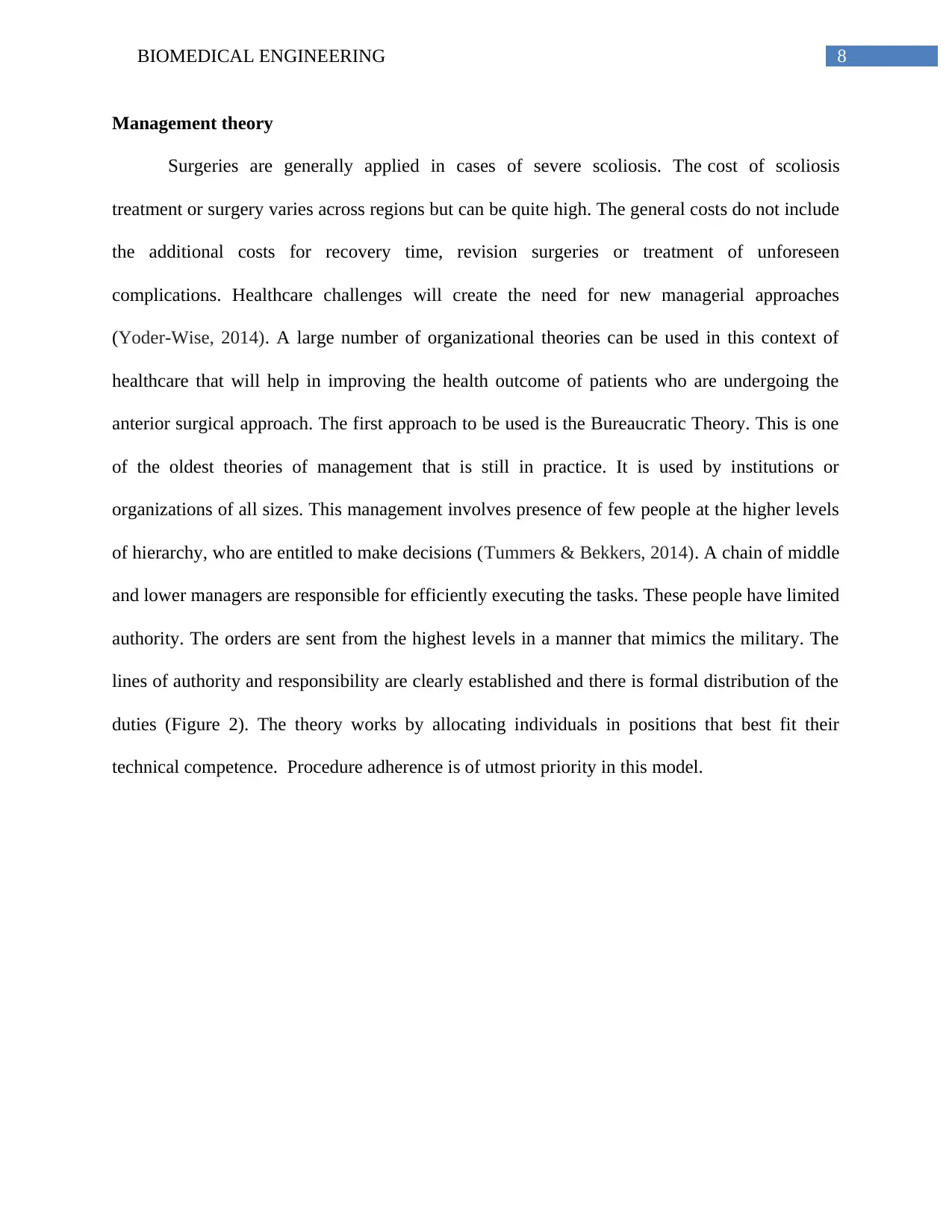
8BIOMEDICAL ENGINEERING
Management theory
Surgeries are generally applied in cases of severe scoliosis. The cost of scoliosis
treatment or surgery varies across regions but can be quite high. The general costs do not include
the additional costs for recovery time, revision surgeries or treatment of unforeseen
complications. Healthcare challenges will create the need for new managerial approaches
(Yoder-Wise, 2014). A large number of organizational theories can be used in this context of
healthcare that will help in improving the health outcome of patients who are undergoing the
anterior surgical approach. The first approach to be used is the Bureaucratic Theory. This is one
of the oldest theories of management that is still in practice. It is used by institutions or
organizations of all sizes. This management involves presence of few people at the higher levels
of hierarchy, who are entitled to make decisions (Tummers & Bekkers, 2014). A chain of middle
and lower managers are responsible for efficiently executing the tasks. These people have limited
authority. The orders are sent from the highest levels in a manner that mimics the military. The
lines of authority and responsibility are clearly established and there is formal distribution of the
duties (Figure 2). The theory works by allocating individuals in positions that best fit their
technical competence. Procedure adherence is of utmost priority in this model.
Management theory
Surgeries are generally applied in cases of severe scoliosis. The cost of scoliosis
treatment or surgery varies across regions but can be quite high. The general costs do not include
the additional costs for recovery time, revision surgeries or treatment of unforeseen
complications. Healthcare challenges will create the need for new managerial approaches
(Yoder-Wise, 2014). A large number of organizational theories can be used in this context of
healthcare that will help in improving the health outcome of patients who are undergoing the
anterior surgical approach. The first approach to be used is the Bureaucratic Theory. This is one
of the oldest theories of management that is still in practice. It is used by institutions or
organizations of all sizes. This management involves presence of few people at the higher levels
of hierarchy, who are entitled to make decisions (Tummers & Bekkers, 2014). A chain of middle
and lower managers are responsible for efficiently executing the tasks. These people have limited
authority. The orders are sent from the highest levels in a manner that mimics the military. The
lines of authority and responsibility are clearly established and there is formal distribution of the
duties (Figure 2). The theory works by allocating individuals in positions that best fit their
technical competence. Procedure adherence is of utmost priority in this model.
⊘ This is a preview!⊘
Do you want full access?
Subscribe today to unlock all pages.

Trusted by 1+ million students worldwide

9BIOMEDICAL ENGINEERING
Figure 2- Bureaucracy theory
IdealBureaucracyDivisionoflabourManagerssubjecttoproceduresandrulesSelectionbasedontechnicalcompetencePositionsorganisedinhierarchyManagementandownershipisseparateDecisionsrecordedinwriting
Figure 2- Bureaucracy theory
IdealBureaucracyDivisionoflabourManagerssubjecttoproceduresandrulesSelectionbasedontechnicalcompetencePositionsorganisedinhierarchyManagementandownershipisseparateDecisionsrecordedinwriting
Paraphrase This Document
Need a fresh take? Get an instant paraphrase of this document with our AI Paraphraser
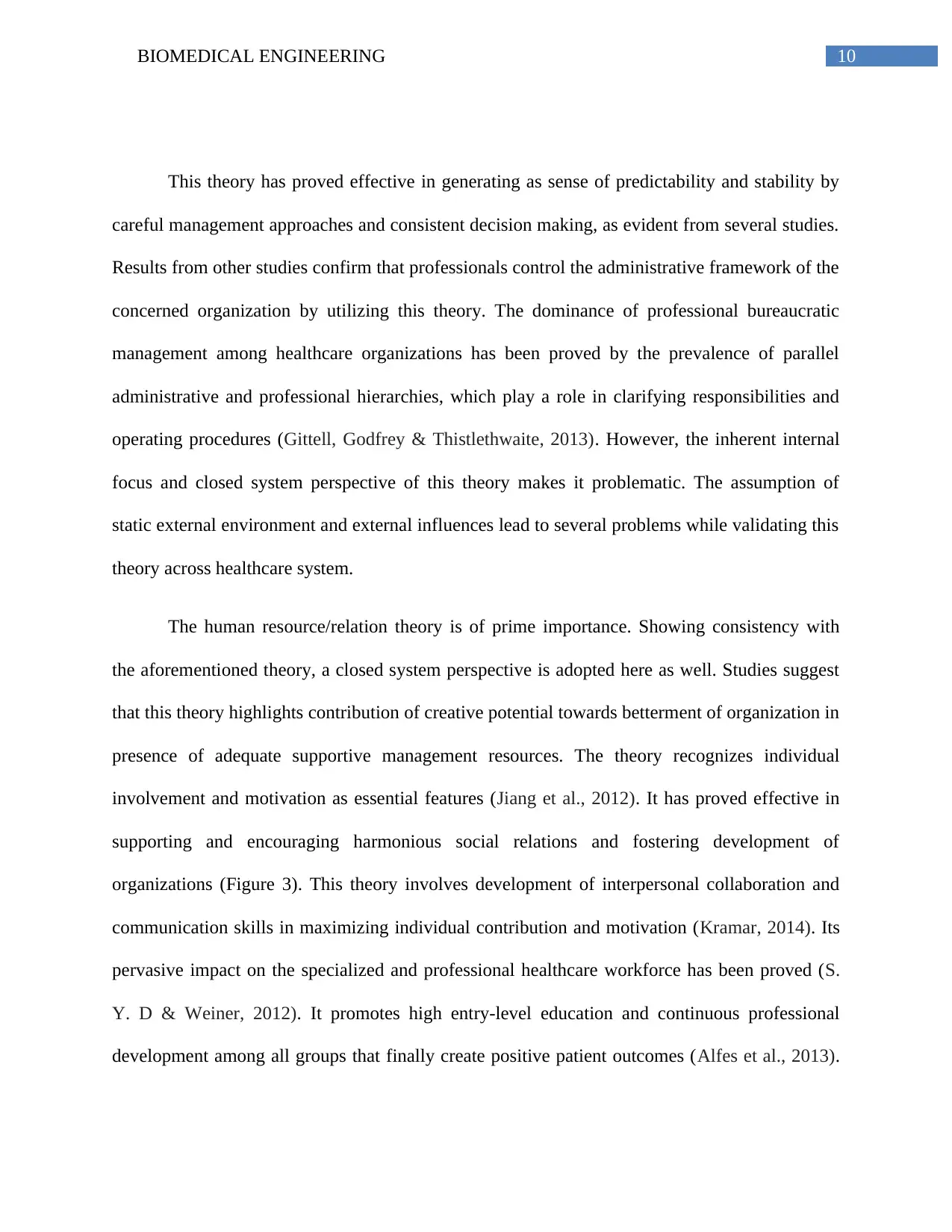
10BIOMEDICAL ENGINEERING
This theory has proved effective in generating as sense of predictability and stability by
careful management approaches and consistent decision making, as evident from several studies.
Results from other studies confirm that professionals control the administrative framework of the
concerned organization by utilizing this theory. The dominance of professional bureaucratic
management among healthcare organizations has been proved by the prevalence of parallel
administrative and professional hierarchies, which play a role in clarifying responsibilities and
operating procedures (Gittell, Godfrey & Thistlethwaite, 2013). However, the inherent internal
focus and closed system perspective of this theory makes it problematic. The assumption of
static external environment and external influences lead to several problems while validating this
theory across healthcare system.
The human resource/relation theory is of prime importance. Showing consistency with
the aforementioned theory, a closed system perspective is adopted here as well. Studies suggest
that this theory highlights contribution of creative potential towards betterment of organization in
presence of adequate supportive management resources. The theory recognizes individual
involvement and motivation as essential features (Jiang et al., 2012). It has proved effective in
supporting and encouraging harmonious social relations and fostering development of
organizations (Figure 3). This theory involves development of interpersonal collaboration and
communication skills in maximizing individual contribution and motivation (Kramar, 2014). Its
pervasive impact on the specialized and professional healthcare workforce has been proved (S.
Y. D & Weiner, 2012). It promotes high entry-level education and continuous professional
development among all groups that finally create positive patient outcomes (Alfes et al., 2013).
This theory has proved effective in generating as sense of predictability and stability by
careful management approaches and consistent decision making, as evident from several studies.
Results from other studies confirm that professionals control the administrative framework of the
concerned organization by utilizing this theory. The dominance of professional bureaucratic
management among healthcare organizations has been proved by the prevalence of parallel
administrative and professional hierarchies, which play a role in clarifying responsibilities and
operating procedures (Gittell, Godfrey & Thistlethwaite, 2013). However, the inherent internal
focus and closed system perspective of this theory makes it problematic. The assumption of
static external environment and external influences lead to several problems while validating this
theory across healthcare system.
The human resource/relation theory is of prime importance. Showing consistency with
the aforementioned theory, a closed system perspective is adopted here as well. Studies suggest
that this theory highlights contribution of creative potential towards betterment of organization in
presence of adequate supportive management resources. The theory recognizes individual
involvement and motivation as essential features (Jiang et al., 2012). It has proved effective in
supporting and encouraging harmonious social relations and fostering development of
organizations (Figure 3). This theory involves development of interpersonal collaboration and
communication skills in maximizing individual contribution and motivation (Kramar, 2014). Its
pervasive impact on the specialized and professional healthcare workforce has been proved (S.
Y. D & Weiner, 2012). It promotes high entry-level education and continuous professional
development among all groups that finally create positive patient outcomes (Alfes et al., 2013).
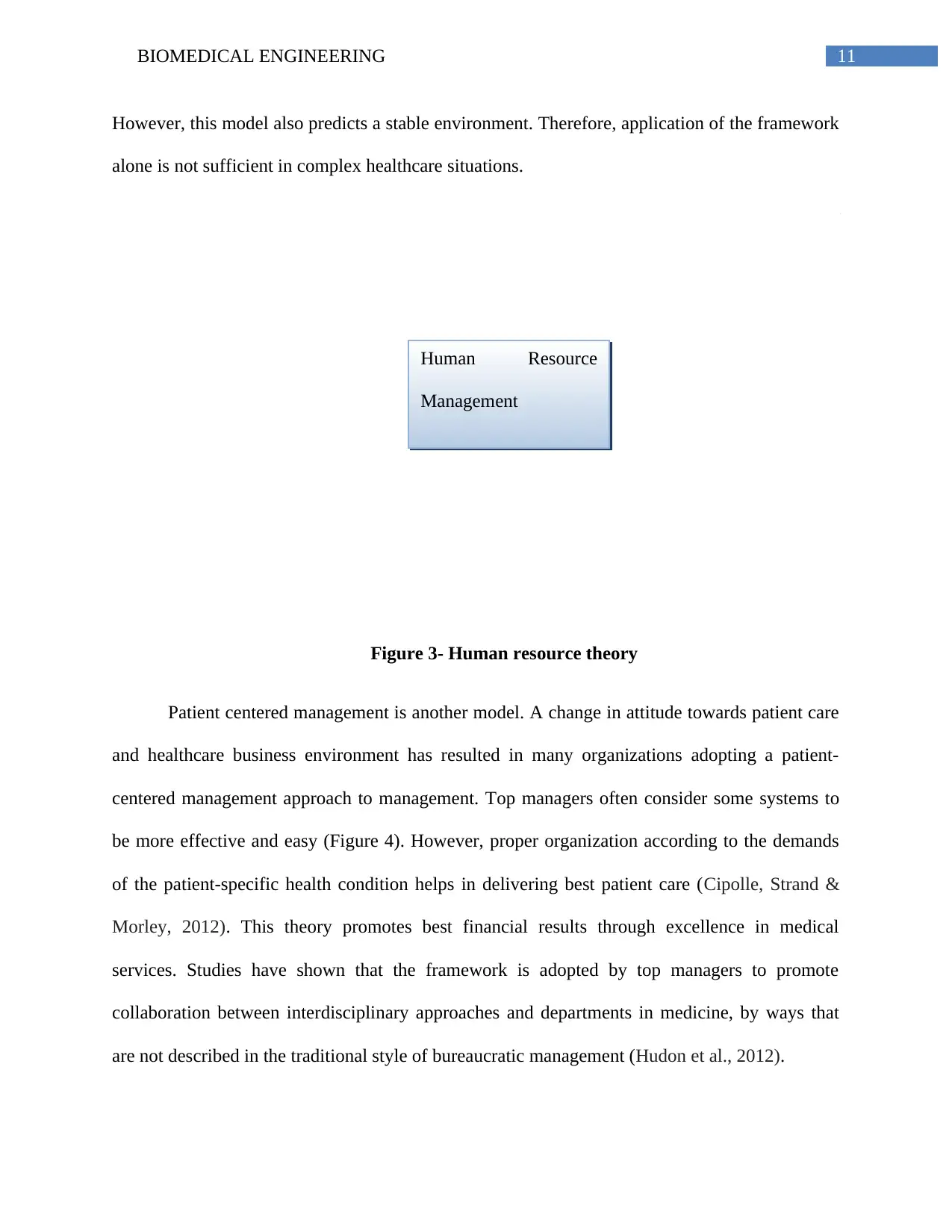
11BIOMEDICAL ENGINEERING
However, this model also predicts a stable environment. Therefore, application of the framework
alone is not sufficient in complex healthcare situations.
Figure 3- Human resource theory
Patient centered management is another model. A change in attitude towards patient care
and healthcare business environment has resulted in many organizations adopting a patient-
centered management approach to management. Top managers often consider some systems to
be more effective and easy (Figure 4). However, proper organization according to the demands
of the patient-specific health condition helps in delivering best patient care (Cipolle, Strand &
Morley, 2012). This theory promotes best financial results through excellence in medical
services. Studies have shown that the framework is adopted by top managers to promote
collaboration between interdisciplinary approaches and departments in medicine, by ways that
are not described in the traditional style of bureaucratic management (Hudon et al., 2012).
Human Resource
Management
However, this model also predicts a stable environment. Therefore, application of the framework
alone is not sufficient in complex healthcare situations.
Figure 3- Human resource theory
Patient centered management is another model. A change in attitude towards patient care
and healthcare business environment has resulted in many organizations adopting a patient-
centered management approach to management. Top managers often consider some systems to
be more effective and easy (Figure 4). However, proper organization according to the demands
of the patient-specific health condition helps in delivering best patient care (Cipolle, Strand &
Morley, 2012). This theory promotes best financial results through excellence in medical
services. Studies have shown that the framework is adopted by top managers to promote
collaboration between interdisciplinary approaches and departments in medicine, by ways that
are not described in the traditional style of bureaucratic management (Hudon et al., 2012).
Human Resource
Management
⊘ This is a preview!⊘
Do you want full access?
Subscribe today to unlock all pages.

Trusted by 1+ million students worldwide
1 out of 24
Your All-in-One AI-Powered Toolkit for Academic Success.
+13062052269
info@desklib.com
Available 24*7 on WhatsApp / Email
![[object Object]](/_next/static/media/star-bottom.7253800d.svg)
Unlock your academic potential
Copyright © 2020–2025 A2Z Services. All Rights Reserved. Developed and managed by ZUCOL.


